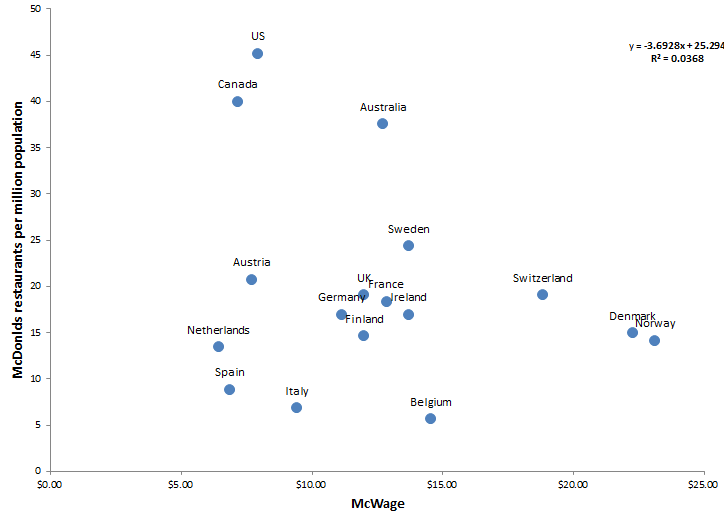America’s favorite ill-informed neoliberal pundit, Matt
Yglesias, has unveiled a masterpiece.
Inspired by the New York Times’ excellent piece about
Denmark’s high fast-food wages -- which are maintained by the power of the United
Federation of Danish Workers -- Yglesias responded with an article headlined, “$20
an hour minimum wage really would cost a lot of people their jobs.” The sage of
Vox believed he had spotted “the crucial fact buried in the 29th paragraph of
the article”: namely, that McDonalds has far fewer restaurants in Denmark
(relative to population) than we do in the U.S.
Conclusion? “Mandating high wages for fast food workers has
more or less the impact you would expect — low levels of fast food employment.”
(But also this ass-covering sentence: “Obviously this is not a slam-dunk proof
that forcing US McDonaldses to pay Danish wages would lead to the closure of
two-thirds of the McDonalds restaurants in the country.”)
Can you really reach that conclusion from a single data
point? Is this data journalism?
The Times draws on research by Oren Ashenfelter and Stepan
Jurajda, who gathered data on McDonalds wages in a number of different
countries. As it happens, I noticed the study last year, and decided to look
into exactly this question -- how the wage levels found related to the number of McDonalds in each
country. It took me a couple hours. Since Vox is so fond of cheap labor, I’m
offering my findings free of charge if they want to use them.
Ashenfelter and Jurajda show the “McWage” for a large number
of countries: the gross hourly wage in 2007 for McDonalds crew workers, not
including benefits or employer taxes. Unfortunately, they haven’t yet reported
the actual numbers in tabular form. They only show each country’s McWage as a
percentage of the U.S. McWage, and you have to read the figures off their
graph, which can be found on page 31 of this, or page 20 of this. Fortunately,
this doesn’t present much of an obstacle.
As for the number of McDonalds
restaurants in each country, you can find those numbers for Europe here (page
6); the company reports the numbers for other countries on the websites of its
national affiliates.
OK, how do the numbers compare? Here’s a graph:
I’ll just point out the obvious. There is no relationship.
The U.S. has a very high number of McDonalds, apparently because McDonalds is a
U.S. company -- not because it can pay low wages. Canada and Australia have similarly high numbers of McDonalds, despite wages at the same levels as European countries with far fewer McDonalds. Denmark has about the same number of McDonalds as Germany and the Netherlands, despite far higher wages. Etc.
Now let’s try to put some dollar figures on this. Assume
that the U.S. McWage was $7.93 in 2007. (That was the highest state minimum
wage in the country at the time: Washington state). Then the dollar figures
would look like this. (I've left the numbers in 2007 dollars; in today's dollars they would be 15% higher. Also note that in their graph, Ashenfelter and Jurajda compare
McWage ratios using market exchange rates, so these numbers reflect that):
Of course, wages are not the only source of labor costs for
an employer. There are also benefits and taxes. Let’s mark up the McWage by the
average employer payroll tax for a low-wage single worker (data from the OECD),
and call that the McLaborCost:
But maybe these numbers are misleading, because market
exchange rates don’t always reflect the domestic price structure. So let’s take
a different tack. Let’s look at the hourly McWage in each country as a ratio of that
country’s hourly aggregate output, with both figures
denominated in the same currency. (Hourly output data from the Conference Board.) Here are the ratios:
And here’s the same comparison using McLaborCost, rather
than the McWage:

So, no. High wages for fast food workers do not have “more
or less the impact” Matt Yglesias would expect. Vox should take down the
article.



